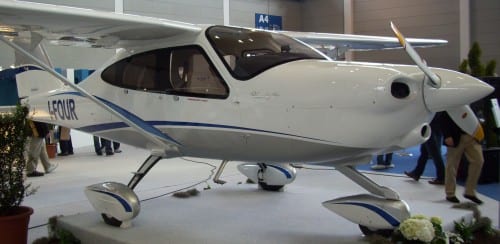While many in the U.S. fret over the future of avgas, especially in light of last week’s announcement by the Center for Environmental Health threatening to sue suppliers and the FBOs that sell leaded fuel in California, the world’s largest producer of light aircraft has been quietly preparing for a lead-free future.
As reported on April 3, Italian LSA maker Tecnam surprised everyone this spring with the announcement of its 11-seat P2012 Traveller, to be powered by twin autogas-burning Lycoming TEO-540-A1A engines. At AERO Friedrichshafen 2011, the company showed off two other new airplanes, the four-seat P2010 and the P92 Eaglet G5 – LY, both powered by autogas-burning engines. These join Tecnam’s wide offering of other Rotax-powered single and twin-engine aircraft which are also best operated using 91+ octane ethanol-free autogas. As confirmed to your blogger by Walter Da Costa, the company’s director of sales and marketing, Tecnam, whose airplanes enjoy growing popularity around the world, are reacting to the disappearance of avgas, especially in developing countries where the primary aviation fuels are autogas and Jet-A.

Tecnam is not alone. At Sun ‘n Fun, Liberty Aerospace announced a Rotax-powered version of its XL2 aircraft. During an interview that appeared on AVWeb, company CEO Keith Markley explained that the primary motivation of the new offering was the ability of the Rotax to run on autogas, crucial to the company’s efforts to enter emerging GA markets in Asia where avgas is seldom available at affordable prices for sport aviators.
For these forward-thinking aircraft manufacturers, it appears that the future aviation fuel is already here. Judging from the reaction we have received at the Aviation Fuel Club, many GA airports in the U.S. understand this too and are scrambling to add autogas as a fueling option as the average price for avgas climbs through $6/gallon.
The GAfuels Blog is written by two private pilots concerned about the future availability of fuels for piston-engine aircraft: Dean Billing, Sisters, Ore., an expert on autogas and ethanol, and Kent Misegades, Cary, N.C., an aerospace engineer, aviation sales rep for U-Fuel, and president of EAA1114.

This should have been done back when the auto industry switched to unleaded fuels. But no, the GA industry insisted they needed 100 octane as the primary aviation fuel. Much to the harm of General Aviation.
Why is it General Aviation insists on being decades behind the auto industry? Give the industry new instrumentation or navigation and they’re all for it. But something critical like what makes an aircraft go and they dig their heels in like someone was dragging them off a cliff.
Think of the savings and the more flight hours that would have happened if this had been done thirty years ago. Sometimes I think General Aviation is its own worst enemy.
Hm, I wonder why business is leaving California and the country.